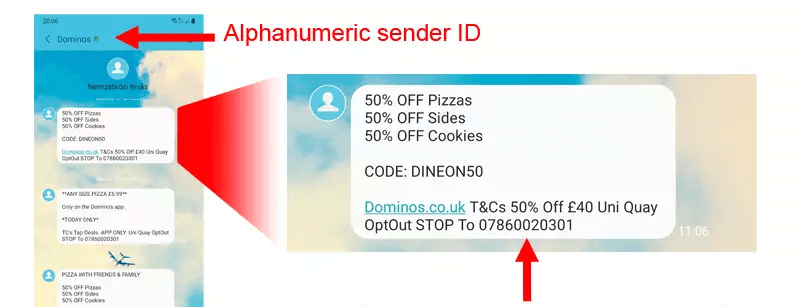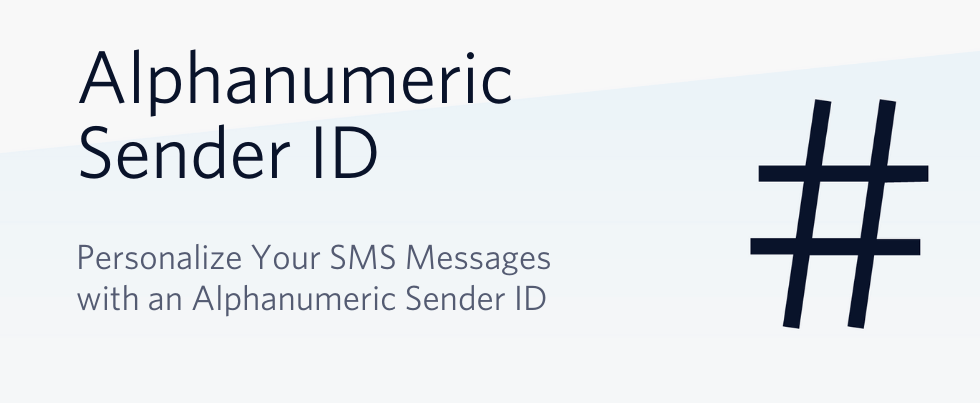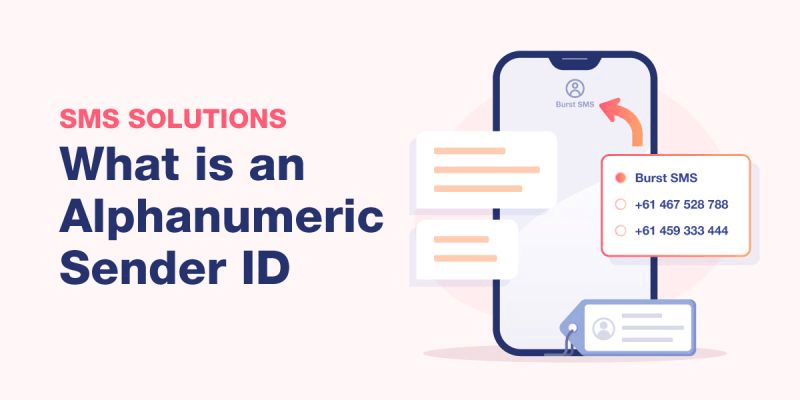📑 Table of Contents
- What Exactly is an Alphanumeric Sender ID?
- Why Should Your Business Use an Alphanumeric Sender ID?
- Crafting the Perfect Alphanumeric Sender ID
- Challenges and Considerations
- Real-World Applications of Alphanumeric Sender IDs
- Best Practices for Implementing Alphanumeric Sender IDs
- Future Trends in Alphanumeric Sender IDs
In today’s fast-paced digital landscape, businesses must seize every opportunity to make their brand stand out. Among the many tools at your disposal, the Alphanumeric Sender ID is a powerful yet often underutilized asset. Whether you’re sending marketing messages, alerts, or notifications via SMS, the right Sender ID can be the key to catching your audience’s attention and establishing trust from the first glance.
What Exactly is an Alphanumeric Sender ID?
An Alphanumeric Sender ID is a customized identifier that businesses use when sending one-way SMS messages. Instead of a random phone number appearing as the sender, your company’s name or brand appears. This identifier can include up to 11 characters, blending letters and numbers, and various mobile networks support it in many countries. While it might seem like a small detail, the impact of an Alphanumeric Sender ID is substantial.
Key Characteristics of Alphanumeric Sender IDs
- Character Flexibility: You can use up to 11 characters, including upper- and lowercase letters, numbers, and spaces. This allows for many possibilities in creating a recognizable brand name.
- One-Way Communication: Alphanumeric Sender IDs are typically used for one-way messaging, meaning the recipient cannot reply to the SMS directly. This makes them ideal for announcements, alerts, or marketing messages without a response.
- Brand Visibility: Using your brand or company name as the Sender ID immediately associates the message with your business, increasing brand visibility and trust.
- Country-Specific Usage: Alphanumeric Sender IDs are not universally supported. Their availability depends on the country and the specific mobile network. Businesses need to verify whether this feature is supported in the regions in which they operate.
Why Should Your Business Use an Alphanumeric Sender ID?
Leveraging an Alphanumeric Sender ID can provide several compelling benefits that can significantly enhance your SMS marketing and communication efforts. Let’s dive deeper into why this tool is so valuable.
1. Instant Brand Recognition
In your customers’ crowded inboxes, an SMS from a random phone number might easily get overlooked or even deleted without being read. However, when your brand name appears as the sender, it instantly grabs attention. The familiarity of your brand encourages recipients to open and read your message, leading to higher engagement rates. This immediate recognition builds a bridge of trust and can significantly influence the effectiveness of your communication.
2. Enhanced Professionalism
Imagine receiving a text from an unknown number versus one that clearly displays the name of a trusted brand. The latter exudes professionalism and credibility, reinforcing the perception of your brand as established and reliable. This is especially crucial in industries where trust is paramount, such as finance, healthcare, and retail.
3. Increased Open Rates
Messages from recognized brands naturally have higher open rates. With an Alphanumeric Sender ID, your SMS stands out amidst the sea of anonymous numbers, ensuring your message is seen and read. Higher open rates lead to more opportunities for customer interaction and conversion.
4. Building and Reinforcing Trust
Trust is a cornerstone of any successful business relationship. By consistently using your brand name as the Sender ID, you reinforce your brand’s presence and reliability. Over time, this familiarity helps to build trust with your audience, making them more likely to engage with your communications and offers.
5. Security and Fraud Prevention
In today’s digital age, security concerns are at an all-time high. Phishing and fraud attempts often occur via SMS, where scammers use random phone numbers to deceive recipients. By using a recognizable Alphanumeric Sender ID, you help mitigate these concerns. Customers can immediately recognize that the message is legitimately from your brand, reducing the chances of your messages being mistaken for spam or malicious content.
6. Global Reach with Local Impact
While Alphanumeric Sender IDs are not universally supported, they are available in many key markets worldwide. Where supported, this feature allows you to maintain a consistent brand presence across different regions. Even in markets with strict local regulations, using an Alphanumeric Sender ID can help you reach your audience more effectively.

Crafting the Perfect Alphanumeric Sender ID
Creating a compelling Alphanumeric Sender ID requires strategic thinking. Here are some essential tips to help you make the most out of this feature:
1. Prioritize Brand Recognition
Your Alphanumeric Sender ID should reflect your brand clearly and concisely. If your brand name is long, consider using a well-known abbreviation that your customers will instantly recognize. Avoid using symbols or characters that might confuse your audience or make the ID look unprofessional.
2. Stay Within the Character Limit
With only 11 characters at your disposal, every character counts. Ensure that your ID is recognizable and fits within this limit. If your brand name is longer than 11 characters, think creatively about how to shorten it while maintaining clarity.
3. Test Across Networks and Regions
Before fully committing to an Alphanumeric Sender ID, testing it across different mobile networks and regions is crucial. Some networks might restrict the characters you can use, and the availability of Alphanumeric Sender IDs can vary by country. Conduct thorough testing to ensure your ID displays correctly and consistently.
4. Consistency is Key
Once you’ve chosen your Alphanumeric Sender ID, use it consistently across all your SMS campaigns. Consistency helps build a strong brand presence and makes it easier for customers to recognize and trust your messages.
Challenges and Considerations
While Alphanumeric Sender IDs offer numerous advantages, they also come with challenges and limitations. Knowing these can help you make informed decisions and avoid potential pitfalls.
1. Limited Availability
As mentioned earlier, not all countries or mobile networks support Alphanumeric Sender IDs. This limitation means you might need to use different approaches in different regions. Always check the regulations and capabilities of each country or network before launching an SMS campaign.
2. One-Way Communication Only
Alphanumeric Sender IDs are typically used for one-way messaging, which means recipients cannot reply to your SMS. If your campaign requires two-way communication, you’ll need to provide an alternative contact method, such as a phone number or email address, within the body of the message.
3. Character Limitations
The 11-character limit can be restrictive, especially for brands with longer names. If your brand name doesn’t fit, you’ll need to find a way to abbreviate it without losing its recognizability. This can be a challenge but is essential for maintaining brand consistency.
4. Potential Misuse
There is a risk that someone else might use an Alphanumeric Sender ID similar to your brand’s name, leading to confusion or fraudulent activity. To mitigate this risk, work with trusted SMS providers and stay vigilant about any unusual activity related to your Sender ID.
Real-World Applications of Alphanumeric Sender IDs

Alphanumeric Sender IDs are used by a wide range of industries to enhance their SMS communication. Here are some real-world examples of how different sectors benefit from this tool:
1. Retail and E-Commerce
Retailers and e-commerce businesses often use Alphanumeric Sender IDs to send promotional offers, order confirmations, and delivery updates. By displaying the brand name as the Sender ID, they ensure that customers immediately recognize the message, leading to higher engagement rates.
2. Financial Services
Banks and financial institutions use Alphanumeric Sender IDs to send important alerts, such as transaction notifications, OTPs (One-Time Passwords), and account updates. The trust that comes with recognizing the sender is crucial in this sector, where security is a top priority.
3. Healthcare
Healthcare providers use Alphanumeric Sender IDs to send appointment reminders, health alerts, and follow-up notifications. Patients are more likely to engage with these messages when they see the name of their trusted healthcare provider as the sender.
4. Travel and Hospitality
Alphanumeric Sender IDs send booking confirmations, travel alerts, and special offers in the travel and hospitality industry. This ensures that customers know the message is from a legitimate source, which is particularly important in preventing fraud.

Best Practices for Implementing Alphanumeric Sender IDs
To make the most of Alphanumeric Sender IDs, it’s important to follow best practices that enhance the effectiveness of your SMS campaigns:
1. Segment Your Audience
If necessary, use different Alphanumeric Sender IDs for various segments of your audience. For example, a retail brand might use one ID for promotional messages and another for customer service updates. This helps maintain clarity and ensures your messages are relevant to the recipient.
2. Monitor Performance
Monitor the performance of your SMS campaigns regularly to see how effective your Alphanumeric Sender ID is. Track metrics such as open rates, click-through rates, and conversion rates to gauge the impact of using your brand name as the Sender ID. This data can provide insights into what’s working and might need adjustment.
3. Ensure Compliance
Always ensure that your use of Alphanumeric Sender IDs complies with local regulations and industry standards. This includes adhering to opt-in requirements, providing clear opt-out instructions, and protecting customer data.
4. Educate Your Audience
Consider educating your audience about the importance of recognizing your Alphanumeric Sender ID. This can be done through email newsletters, social media posts, or even a dedicated page on your website. By informing customers about your official Sender ID, you help them identify legitimate communications from your brand.
Future Trends in Alphanumeric Sender IDs
As SMS marketing continues to evolve, the role of Alphanumeric Sender IDs is likely to grow. Here are some trends to watch:
1. Increased Global Adoption
As more countries and networks support Alphanumeric Sender IDs, we expect wider adoption across industries. This trend will allow brands to maintain consistent messaging and branding in more global markets.
2. Integration with Multi-Channel Campaigns
Alphanumeric Sender IDs will likely become a key component of integrated multi-channel marketing campaigns. By using the same Sender ID across SMS, email, and other communication channels, brands can create a seamless and cohesive customer experience.
3. Enhanced Security Features
As security concerns continue rising, we may see enhanced features related to Alphanumeric Sender IDs. This could include stricter regulations on using Sender IDs and new technologies to prevent misuse or fraud.

Conclusion
An Alphanumeric Sender ID is more than just a tool for SMS marketing; it’s a vital part of your brand’s identity in the digital world. By using your brand name as the Sender ID, you can boost recognition, build trust, and enhance the overall effectiveness of your communication strategies.
While there are challenges, the benefits of using an Alphanumeric Sender ID far outweigh the limitations. By following best practices and staying informed about the latest trends, you can make the most of this powerful feature and ensure your brand stands out in every customer interaction.
In a world where every message counts, an Alphanumeric Sender ID is a small detail that can make a big difference. Start using this feature today and watch your SMS campaigns reach new heights of success.
